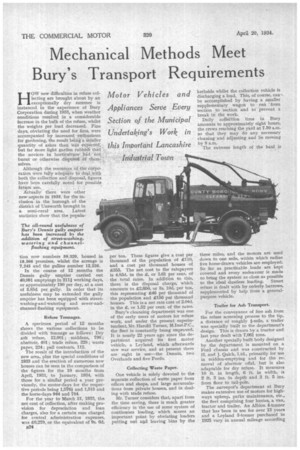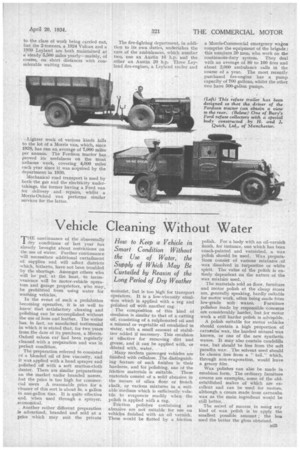Mechanical Methods Meet Bury's Transport Requirements
Page 38

Page 39

If you've noticed an error in this article please click here to report it so we can fix it.
Motor Vehicles and Appliances Serve Every Section of the Municipal Undertaking's Work in this.Important Lancashire Industrial Town HOW new difficulties in refuse collecting are brought about by an exceptionally dry summer is instanced in the experience of Bury Corporation during 1933, when weather conditions resulted in a considerable increase in the bulk of the refuse, whilst the weights per load decreased. Fine days, obviating the need for fires, were accompanied by increased -enthusiasm for gardening, the result being a smaller quantity of ashes than was expected, but far more light garden rubbish that the novices in horticulture had not burnt or otherwise disposed of them
selves. . .
Although the resources of the corporation were fully adequate to deal with both the collection and disposal, 'figures have been carefully noted for possible future use. .. . -...
Actually there were other new 'aspects in 1933, for the inclusion in the borough of the district of Unsworth brought in a semi-rural area. Latest statistics show that the popula
tion now numbers 59,320, housed in 18,366 premises, whilst the acreage is 7,245 and the gullies number 12,226.
In the course of 12 _months the Dennis gully emptier carried out 40,091 emptyings in 211i working days, or approximately 190 per day, at a cost of 3.85d, per gully. In order that its usefulness may be extended the gully emptier has been equipped with streetwashing-and-watering and sewer-andchannel-flushing equipment.
Refuse Tonnages.
A specimen period of 12 months shows the various collections to be divided with tonnage as follows.: Dry ash refuse, 12,001; middens, 796; abattoir, 401; trade refuse, 328; waste paper, 224; pail contents, 112.
The result of the introduction of the new area, plus the special conditions of 1933 and the erection of numerous new houses can be seen in the comparison of the figures for the 10 months from April, 1933, to January, 1934, with those for a similar period a year previously, the motor-days for the respective periods being 1,576i and 1,515 and the horse-days 944 and 784.
For the year to March 31, 1933, the net cost of collection, after making provision for depreciation and loan charges, also for a certain sum charged for central administration expenses, was £6.279, or the equivalent of 9s. 6d.
524 per ton. These figures give a cost per thousand of the population of £110, and a cost per thousand houses of £355. The net cost to the ratepayers is 4.83d. in the £, or 3.61 per cent. of the total rates. In addition to this, there is the disposal charge, which amounts to £2,650, or 3s. 10d. per ton, this representing £46 per thousand of the population and £150 per thousand houses. This is a net rate cost of 2.04d. in the £, or 1.52 per cent. of the rates. Bury's cleansing department was one of the early users of motors for refuse work, and under the present superintendent, Mr. Harold Turner, M.Inst.P.C., the fleet is constantly being improved. It is nearly 22 years ago since the department acquired its first motor vehicle, a Leyland, which afterwards saw war service, and at present there are eight in use—the Dennis, two Overlands and five Fords.
Collecting Waste Paper.
One vehicle is solely devoted to the separate collection of waste paper from offices and shops, and large accumulations from private houses, and in dealing with trade refuse.
Mr. Turner considers that, apart from the time saving, there is much greater efficiency in the use of some system of continuous loading, which scores an important point by obviating loaders putting out and leaving bins by the kerbside whilst the collection vehicle is discharging a load. This, of course, can be accomplished by having a Smaller supplementary wagon to -Tun from section to 'section and to prevent a break in the work.
Daily collection time in Bury amounts to approximately' eight hours, the crews reaching the yard at 7.30 am. so that they may do any necessary cleaning and adjusting and be movingby 8 a.m. The extreme length of the haul is three miles, and the motors are used down to one mile, within which radius five horse-drawn vehicles are employed. So far as practicable loads are kept covered and every endeavour is made to bring the system as close as possible to the ideal dustless loading. Street refuse is dealt with by orderly barrows, supplemented by help from a generalpurpose vehicle.
Trailer for Ash Transport.
For the conveyance of fine ash from the refuse screening process to the tip, a distance of roughly i-mile, a trailer was specially built to the department's design. This is drawn by a tractor and last year dealt with 7,061 tons. Another specially built body designed by the department is mounted on a Ford chassis and was constructed by H. and J. Quick, Ltd., primarily for use in midden-emptying and for the removal of abattoir offal, but is also adaptable for dry refuse. It measures 10 ft. in length, 6 ft. in width, is 2 ft. 3 ins, in depth and 3 ft. 5 ins. from floor to tail-pole.
The surveyor's department at Bury makes extensive use of motors for highways upkeep, parks maintenance, etc., the fleet comprising four lorries, a van, tractor and trailer. An Albion 4-tonner that has been in use for over 13 years and a Leyland 3-tonner purchased in 1925 vary in annual mileage according
to the class of work being carried out, but the 2-tonners, a 1924 Vulcan and a 1930 Leyland are both maintained at a steady 5,500 miles yearly—mainly, of course, on short distances with considerable waiting time.
Lighter work of various kinds falls to the lot of a Morris van, which, since 1928, has run an average of 7,000 miles per annum. The Fordson -tractor has proved its usefulness on the most arduous work, covering 4,000 miles each year since it was acquired by the department in 1930.
Mechanical road transport is used by both the gas and the electricity undertakings, the former having a Ford van for delivery and repairs, whilst a Morris-Oxford van performs similar services for the latter. The fire-fighting department, in addition to its own duties, undertakes the care of the ambulances, which number two, one an Austin 16 h.p. and the other an Austin 20 h.p. Three Leyland fire-engines, a Leyland trailer and
a Morris-Commercial emergency wagon comprise the equipment of the brigade; this numbers 20 men, who work on the continuous-duty system. They deal with an average of 80 to 100 fires and about 2,000 ambulance calls in the course of a year. The most recently purchased fire-engine has a pump ca.pacily, of 700 gallons, whilst the other two have 500-gallon pumps.




























































































